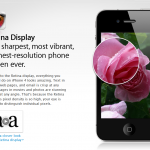[youtube]http://www.youtube.com/watch?v=UIeCeBwRvpA[/youtube]
Tehnologia Retina Display reprezinta practic un ecran high-end cu de 4 ori mai multi pixeli per inch decat intr-un ecran normal, iar implementarea acestei tehnologii a stat la baza calitatii exceptionale a imaginilor afisate pe ecranul noului iPhone 4. Noul ecran al iPhone 4 are o rezolutie de 326dpi care permite, dupa cum explica Steve Jobs, vizionarea unei imagini la o distanta de pana la 12 inch, aceasta fiind distanta pana la care ochiul uman poate percepe pixelii.
All the breakthrough technology in iPhone 4 is situated between two glossy panels of aluminosilicate glass – the same type of glass used in the windshields of helicopters and high-speed trains. Chemically strengthened to be 20 times stiffer and 30 times harder than plastic, the glass is ultradurable and more scratch resistant than ever.
Ecranul iPhone 4 va fi tot de 3.5″ ca si iPhone 3GS/3G insa spre deosebire de celelalte noul ecran este construit printr-un proces de laminare optiune care presupune un proces tehnologic complex prin care o suprafata de sticla este laminata pe display-ul telefonului, asta ducand la cresterea durabilitatii(si a rezistentei la zgarieturi) si, dupa cum spune Apple, duce la eliminarea refractiei luminii in ecran.
Noua tehnologie imbunatateste in mod considerabil felul in care iPhone 4 afiseaza imaginile pe display, o calitate comparabila cu imaginile afisate de un ecran AMOLED, ramane totusi de vazut niste teste in lumea reala intre cele 2 terminale. Iata cateva detalii tehnice :
- rezolutie de 960 x 640 pixeli;
- Contrast 800:1, de 4 ori mai bun ca la iPhone 3GS;
- tehnologie IPS care permite vizualizarea clara a imaginilor din diferite unghiuri;
- 78% din pixelii existenti in ecranul iPad sunt prezenti in cel al iPhone 4.
























